WAYS WITH CHOCOLATE
The Horticultural Way
The classic gift for your sweetie on Valentine’s Day is, of course, chocolate.
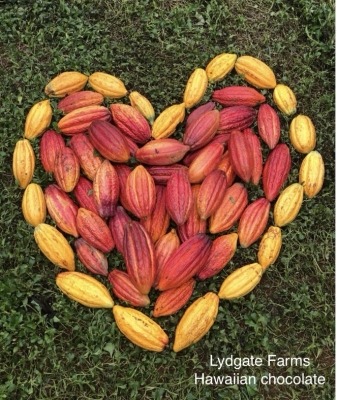
Chocolate plant pods
But plain old chocolate won’t do, not even rich Theo or Equal Exchange chocolates (my two favorites). The gift is going to be a chocolate plant — this is about gardening, after all.
Plant a Hershey’s Kiss and it’ll never sprout to become a chocolate tree. Plant a chocolate seed and it also might never sprout to become a chocolate tree.
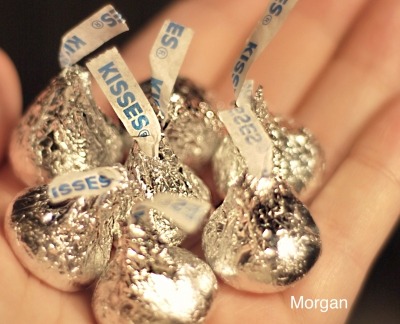
Chocolate kisses
Chocolate seeds have very limited viability. Fresh, they’re nestled in what looks like a cottony mass that keeps them properly moist for sprouting. The covering is actually slimy, though, and starts to rot away as soon as the seeds are out of the pods.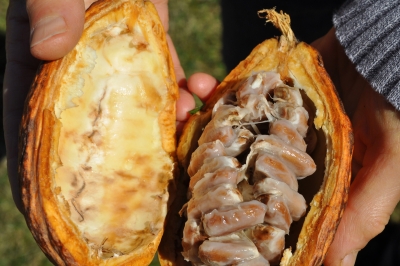
You might still want to give the seeds as a gift — perhaps cradled in a gift box on some moist, real cotton — as a gardening challenge. Make sure your Valentine sprouts rather than eats them. The raw seeds are bitter and can upset the stomach. On the other hand, that cottony covering around the seeds in the pod is very delicious, tasting like pineapple or mango and being sweet or tart, depending on growing conditions and the genetics of the particular plant. Or so I’ve read and been told, having never tasted it myself.
To sprout, the seeds need warmth and well-drained soil, the latter especially important because they are prone to rotting. Plant very shallowly, even with the seed showing above the soil because germination is epigeal, so the seed needs to be able to lift itself out of the ground as roots tunnel downward.
A Little Quicker and Easier
A chocolate plant that’s up and growing makes a more dramatic gift than a few seeds snuggled in cotton. Not that caring for an already growing chocolate plant isn’t still a challenge.
Chocolate is native to tropical lowlands of Central and South America within twenty degrees on either side of the equator. There, neither the temperature nor the humidity ever drops much below about seventy.
Contrast tropical conditions with those in the average northern home in winter. Yes, temperatures here might hover around seventy degrees, although many of us let the temperature drop in the night. A bigger problem is humidity, which typically is less than forty percent. Frequently misting the plant, standing the pot in a saucer of pebbles and water, and clustering it close to other plants all help to bring the humidity up.
Or grow it indoors in its own mini-greenhouse made of glass, clear acrylic, or plastic film. I’ve made terrariums by gluing together cut class of various shapes with silicone glue.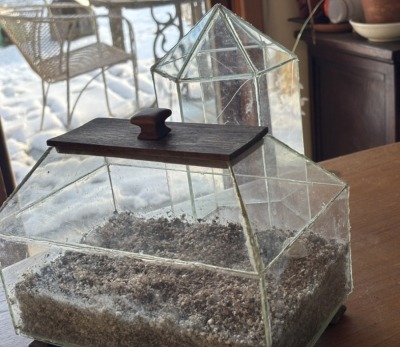
Chocolate naturally grows as an understory tree and even under cultivation is grown in shade, so providing sufficient light does not present much of a problem in growing a potted plant indoors. In the tropics, 30 percent shade increased production in the long run.
Your indoor plant won’t tolerate a dark room, though. Direct your Valentine to set the plant at a sunny window, which in midwinter here at the farmden (about 42° latitude), receives about the same amount of light as a partially shaded tree near the equator. As winter progresses and our sun loops higher into the sky, the plant needs to be pulled back from the window to keep the leaves from burning.
An indoor chocolate plant appreciates an annual vacation to the “tropics.” Give it one, or something close, by moving it outdoors to dappled shade each summer to bask in buoyant air and high humidity.
Finally, To Eat
So much for growing chocolate; what about eating it? With good growing conditions, football-shaped pods a half-foot to a foot long will pop right out of the trunk or stems within about five years for a seed-grown plant, a couple of years for a nursery-bought plant. Only few of the flowers typically turn into fruits, and fruits take about eight months to mature.
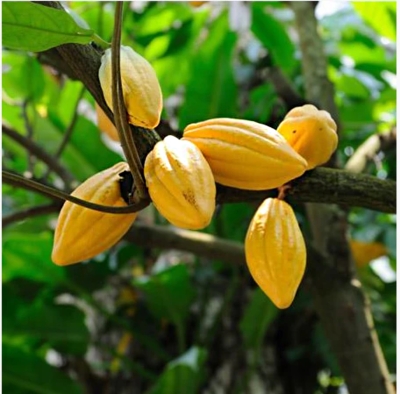
Even when ripe, a chocolate pod is not a fruit to pluck right off the tree and chomp down on. First of all, there’s the hard shell.And secondly, the seeds — called cacao beans at this point — only after some processing do they taste like “chocolate” and not cause stomach upset.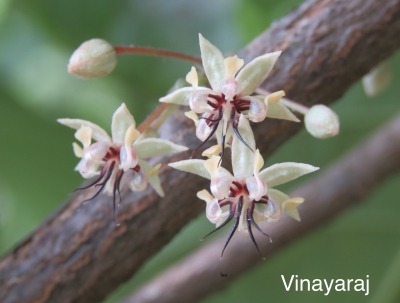
Cacao beans are converted to cocoa then chocolate by first letting the slimy, cottony covering ferment as the beans are piled together and kept warm for about a week. After a few more days of drying, the chocolate-y flavor starts to emerge. Next, the seeds are roasted at 270°F for several hours. Finally, they’re ground up and treated with alkali to remove bitterness. Defatted and powdered, you have “cocoa.” With some fat, sweetener, and other ingredients such as milk, you have various kinds of “chocolate.”
Use of chocolate goes back to the Mayans, who considered it a gift from their god of air, Quetzalcoatl. The Spanish were the first Europeans to get hold of chocolate pods and, fifty years later, figured out what to do with them.
After harvest begins, you might want to snuggle up with your Valentine and sip hot chocolate from this 16th century Spanish recipe: Combine 50 cacao beans with a chile pepper pod, a quarter pound of sugar, and some anise, rose blossoms, cinnamon, almonds and hazelnuts; grind to a paste, add a cup of boiling water, and serve hot and steamy.
Or simpler, roasted and ground cacao seeds mixed with chilies, water and cornmeal. Mayans poured this mixture from one pot to another, creating a thick foamy beverage called “xocolatl”, meaning “bitter water.”
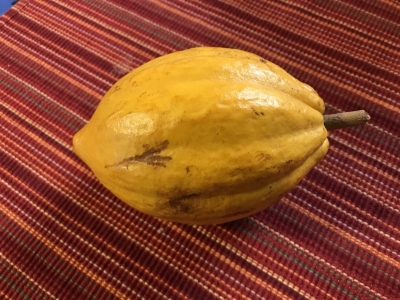
Cacao pod


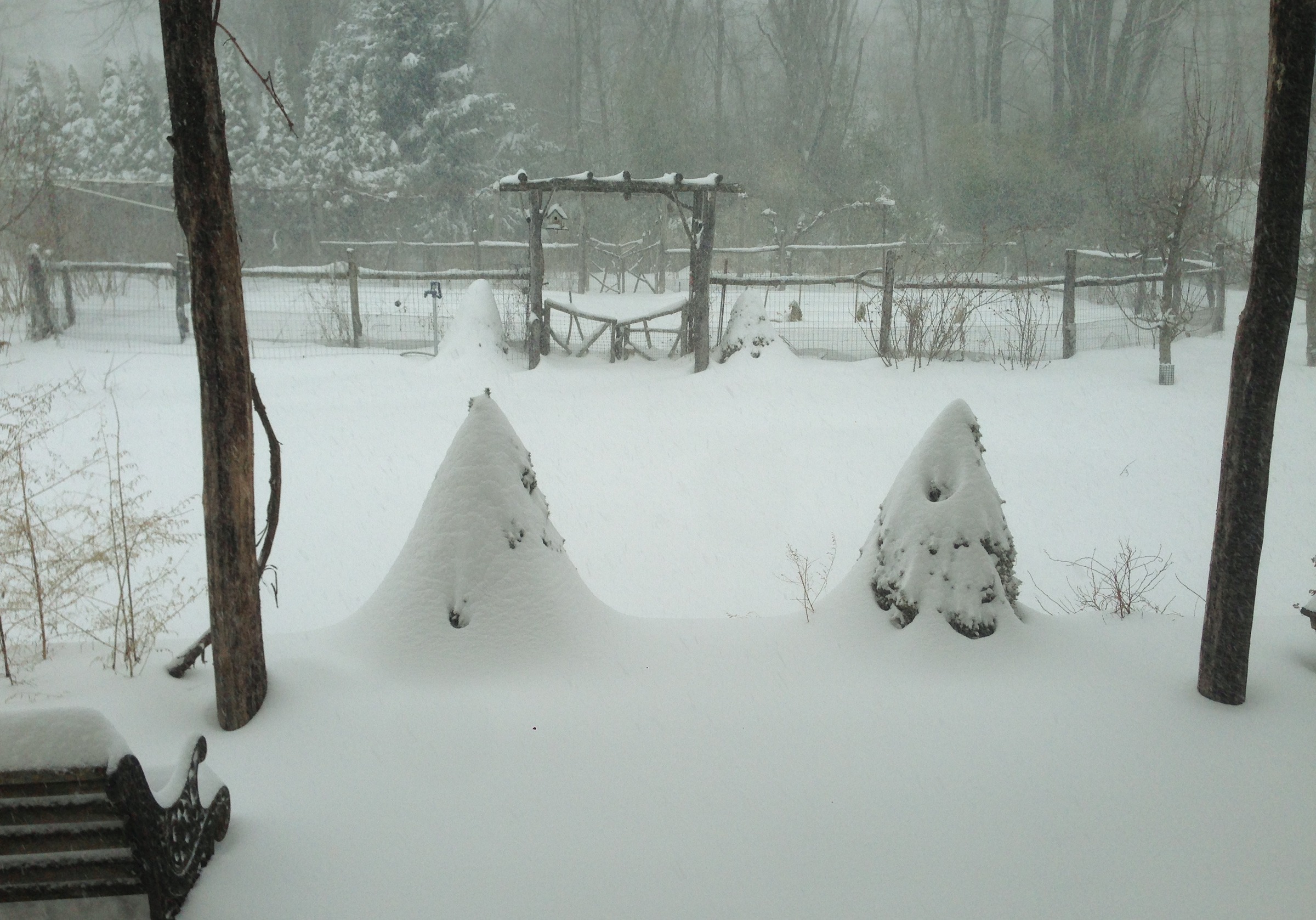
Mr.Reich I owe so much to you.Thank you so much for your wonderful sense of humor. Your amazing ability to write. I believe I have all your books.I just received your beautiful little book of water color pictures of fruit of yesteryear. Simply put outrageously beautiful.. Mr Reich you are my mentor and don’t know it but you are. At this very moment I am reading Growing Figs in cold climates for the 4th time.and your pruning book both editions. I am going to repot some figs tomorrow and I just love your writing. Thank you sir
Cheers
Thomas Schwartz
Thank you so much for those kind words.
Mr.Reich I was to send you a book or two with a self addressed envelope. Would you mind signing them? They would be your books. I hope you got a chuckle out of that. I truly find your sense of humor and of course writing to be one of my favorites.
Sincerely
Thomas Schwartz
Sure. I assume you mean you already have copies of the books, which you’re going to mail to me, and want me to sign and return them.